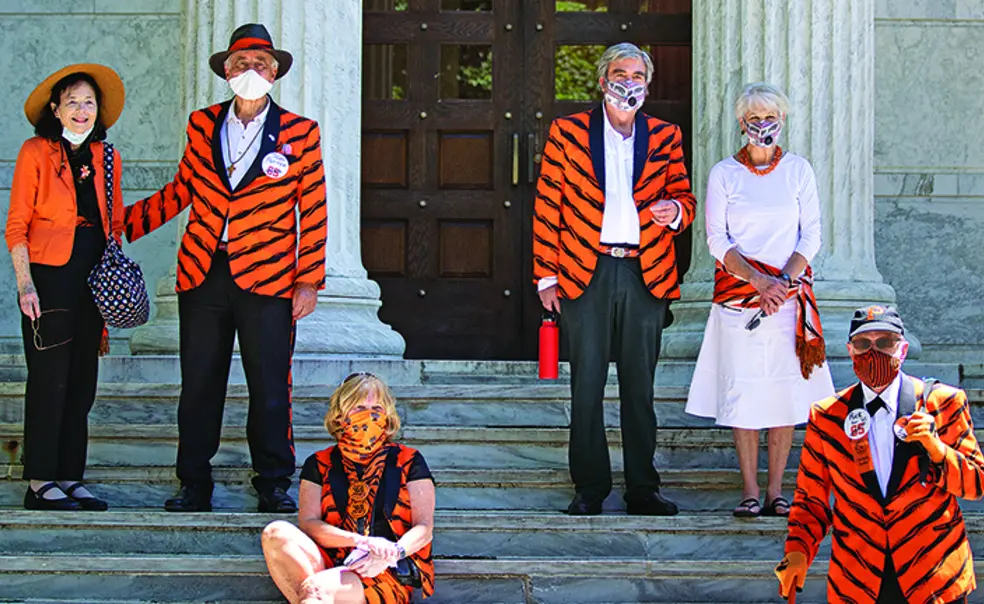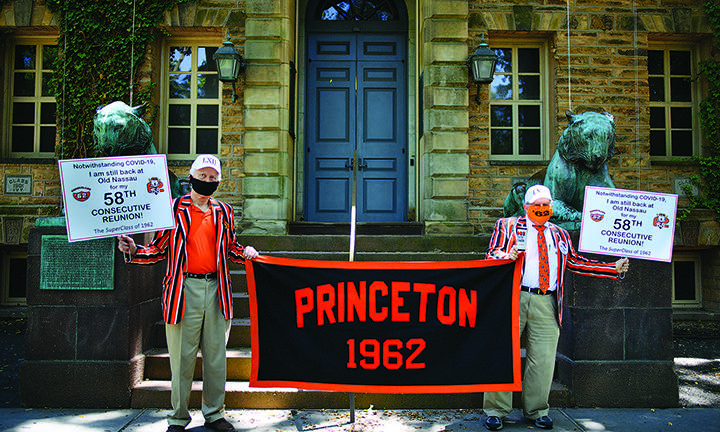A Princeton First: Reuning Together, Apart
Class of 1970 co-president George Bustin ’70 was skeptical about this year’s virtual Reunions — a Princeton first — but he came away impressed. “The virtual P-rade was very well done, entertaining, nostalgic,” he said. “Of course it was no substitute for the ‘real’ thing, but as good as possible in the circumstances.”
The effort required a nimble pivot by the Alumni Engagement team, which within eight weeks assembled a virtual celebration with about 200 events, according to Deputy Vice President for Alumni Engagement Alexandra Day ’02. She described the weekend as a “gift at a moment when we felt like we all need community, healing, and uplift more than ever.”

Some alumni might even have preferred a few of the virtual events. The Alumni Council meeting is normally held over lunch in a stifling Rockefeller Dining Hall for a capacity audience of about 200; this year, Chair Rich Holland ’96 presided with a Zoom backdrop of Rocky while more than 400 alumni “attended” in comfort. President Eisgruber ’83, wearing his black-and-orange-stripe class jacket, gave his traditional address from what looked like a home library.
A highlight of the Alumni Council session was Eisgruber’s presentation of the silver-topped Class of 1923 cane to 105-year-old Joe Schein ’37. The cane is awarded to the oldest alum in the oldest class to march in the P-rade; while there was no actual marching this year, Schein made a short acceptance speech.
“Reunions is a feeling,” Holland said, suggesting that the feeling remained even if the events were virtual. “Reunions is an embodiment of our great alumni experience.”
Eisgruber, who usually meets with alumni at a “town hall” meeting in Richardson Auditorium, this year updated more than 900 listeners from his office, focusing largely on the pandemic. Princeton was preparing to reopen libraries and restart research as soon as the state allowed it, he said. Graduate programs were expected to resume in the fall, though it remained unclear how undergraduate education would proceed.
Faculty members have been asked to prepare under the assumption that undergraduate classes will be online in the fall, Eisgruber told alumni, noting that there would be a “hybrid” experience at a minimum, since travel restrictions probably mean that not all students would be able to return.
In the question-and-answer period (alumni submitted questions through the platform’s chat function), Eisgruber addressed COVID-19’s effects on Princeton’s budget. Spending from the endowment would increase for the short term, but that strategy was not sustainable — and the University was “beginning to exercise some budget discipline” to protect teaching and research, he said.
One alumna mentioned the protests stemming from the death of George Floyd and asked Eisgruber how Princeton was addressing issues of race. The president noted Princeton’s efforts to diversify the student body, saying recent events illustrate why that is so important.
Perhaps the most impressive bit of programming was the virtual P-rade, an hourlong pre-recorded homage to alumni — especially to this year’s major Reunions classes. The video began with lighthearted facts about the P-rade — this year, called the V-rade — and was kicked off by Schein leading the Old Guard. As the oldest alumnus for the past five years, Schein typically wows onlookers by walking the entire P-rade route. This year, it was his empathy and eloquence that won the day. In a recorded message, he said holding Reunions despite the pandemic was “a sign of love in another time of great uncertainty. My Princeton experience transformed my life … and continues to do so in my prolonged senescence.” Addressing the Class of 2020, he acknowledged that it is entering a world of turmoil but also “one of infinite possibilities.”
From there, the classes “processed” in their usual order, each class announced by P-rade narrator Gary M. King ’79, accompanied by lively music and a photo collage from Reunions past. For the major Reunions classes and the APGA, there were also class photos taken over Zoom and recorded messages from their leaders. The Class of 1990 flashed several screens filled with faces in a Zoom grid for a total of 237 classmates, the biggest class photo of the event. Throughout the photo montages, P-rade marshals popped up in an inset box with familiar admonitions, such as “Please keep your feet out of the street, boys and girls!” and “Please, please don’t pass alcohol to the Old Guard!”
Most classes’ messages included words of support for the 2020 grads. “The exceptional talent and potential in your class and the resources and resilience of Princeton’s alumni body as a whole will carry us through this onto better days,” said Bustin in his recorded message. The P-rade concluded with a locomotive comprising 160 alumni whose video recordings were edited together.
Evening programming included Zoom tent parties, where DJs and bands performed for grids of alumni partying along in their driveways and kitchens and catching up with each other using the platform’s chat function.
“Short of virtual reality, that was as good as it gets,” said Reunions co-chair Meaghan Byrne ’10, whose tent party of about 260 attendees was entertained by the ’80s cover band Rubix Kube.
Speaking in early June, Day said the University had invited the classes of 1970 and 1995 to return to campus next year to make up their celebrations. Other classes might follow the example of 2010, which next year will have a Friday-night event at Morven, the former New Jersey governor’s mansion, before joining in the P-rade on Saturday. But any planning for next year, Day acknowledged, could still be derailed by the virus.
Day said she had heard from many alumni who hoped the virtual events could continue as a supplement to in-person activities, and that her team is looking at all options. Still, she said, “part of the success of this year is our audience was only a digital one, so we could really tailor what we were doing for those tuning in digitally.”
“I’m grateful and proud of my colleagues and alumni for stepping up, but I don’t think [virtual Reunions] could ever replace what we feel and do when we come together in person,” she said. “It will inform how we approach Reunions planning in the future, but it will by no means eclipse what we have been trying to do with this beautiful tradition for many, many decades.”













1 Response
Margaret M. McGlynn ’86
5 Years AgoA Poem for Reunions
In April 2019, I was invited to a Nassoon Reunion in Riverside, California. The men in this group graduated in the 1960s and ’70s. My father, Rich McGlynn ’60, couldn’t make it out to Southern California, but my husband and I were able to attend. It was a lovely occasion with beautiful music at Riverside’s Mission Inn, and I wrote a poem about it:
Song of Princeton, 50 Years Gone
Attenuated gents arrayed in school ties
Some totter, one in a wheel chair, many still in golden voice
gathered to croon melodies of yearning, tomfoolery,
desire and wonder, to bask in glory days.
Among stucco domes and spires, a mythic Mission past,
Huntington-plundered masterworks for wallpaper
Beneath a velvet pall that kills sound, they sing
braving elaborate arrangements, often well.
Men’s voices vibrate through chests and hearts.
Warm old organ pipes with smiling faces.
Singing “Tenderly” and “The Night Herder’s Song”
“Give your mom and dad my best,” they say, each one.
Dinner arrives on storied plates of white privilege
of how Dad saved their teenage marijuana-smoking asses
from jail, and it was all such fun. How mighty fine it is
to be white, and male, and not even know your luck.
But an Olympic daughter of a now-dead singer
finds me, hugs a picture of her father to her chest
and tearfully says, “...all the things I never asked him.
oh, the things I’ll never tell him. Thank your Dad for me.”
This splendid dying world, these odes, love harmonized,
inescapable, fading joy, tiger lily petals curling, wilting.
So I will walk again with Dad between spire and tower,
beneath vaulted stone, to blend my voice with ringing lyres.
Editor’s note: In addition to being poet and MFA graduate of the Vermont College of Fine Arts, the author was music director for the Princeton Tigerlilies from 1984-86.